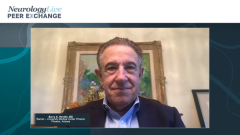
Considerations for Using High-Efficacy Therapy in MS
Expert neurologists discuss factors guiding their choice of high-efficacy therapy in multiple sclerosis.
Episodes in this series

Ahmed Z. Obeidat, MD, PhD: Dr Berkovich, you mentioned that we have several classes of high-efficacy therapy. Do you have any specific things that drive your selection, whether it’s patient-related factors, route of administration, or other factors that you can speak to? Then we’ll also hear from Dr Hendin about this.
Regina Berkovich, MD, PhD: It could be my personal situation. My PhD is in pharmacology, so I have a lot of respect for FDA or EMA [European Medicines Agency] approval. It’s a big deal that the medications go through the pivotal studies—phase 2 and 3 studies—and get FDA approval. This is a huge deal because it means that this medication was selected out of hundreds and went through every single state of approval. It’s important to acknowledge.
When I look at my patients, I carefully review their medical history. Patients provide you with very valuable information from the standpoint of what comorbid disorders and diseases they have. That’s my practice, my personal experience, and my publications are based on that experience. If the patient has comorbid psoriasis, for example, then you think, “What type of immune system is being engaged here?” You think psoriasis is purely a T-cell–driven disease. It’s similar to MS [multiple sclerosis] and probably has even less of a B-cell role than MS. Then you think that maybe that person would be better to be started on, in my opinion, natalizumab. We have some great experiences with it, which we published.
Or this patient may have comorbid high titer of AMA [antimitochondrial antibody]. Even without being diagnosed with pure lupus, you understand nevertheless that in this individual, the B-cell–driven disease plays a very important role. That may drive your decision toward B-cell depletion therapies. That would be using some signals and keys from the immune system and making more or less an educated decision.
Or your patient may have comorbid situations with very frequent UTIs [urinary tract infections], for example. Now you have to think about choosing medication that would have less tendency to predispose this patient to chronic bacterial disorders. In this case, B-cell depletion therapies may not be the best choice. Perhaps you should look at an option like cladribine, where you have a very brief interval of immune suppression followed by propagation and reproduction of the immune system so that the period of lymphopenia the patient will experience will be relatively short. It’s interesting that the pandemic was very illustrative in proving that this approach with keeping infections in mind is very supportive of this type of hypothesis.
Ahmed Z. Obeidat, MD, PhD: Thank you very much. This is very helpful. You touched on several mechanisms of the disease—MS has multiple mechanisms—and you touched on how in some patients it may be a T-cell–predominant disease, and other patients may have more of a B-cell type of disease. This all has to be unraveled more. There are more details to be understood where patients may be deconstructed into different subtypes in the future. That’s 1 thing we may see in the future.
Dr Hendin, when you think about high-efficacy therapy and selecting some of those therapies for your patients, what factors—patient factors, disease factors, other factors—drive your selection? I’d like to hear from you.
Barry A. Hendin, MD: Regina did a nice job going through the multiple individual factors that play a role. I’ll take a personal view of how I tend to collaboratively make these decisions. I tend to see if the patient is philosophically aligned with me and in favor of the use of a higher-efficacy agent. If so, the discussion revolves around a few agents, not around 23 or more. At that point, if you asked whether the route of administration makes a lot of difference to me, the answer is not a lot to me, but it may make a lot of difference to my patients.
I’ve already said to that person, “We have several agents that fit into that group that we’ve discussed. There are ones delivered by infusion. There are those delivered by injection. There are those delivered by pills.” They will tell me verbally or nonverbally what their preferences are. They may say what they prefer, or they may wince and pull back at other choices. There’s a large degree of route of administration that will relate to patient preference. Some patients don’t want injections or shots. Some patients want infrequent interventions. We shouldn’t forget the third party in the room, the payer. Sometimes the patient and I have made a wonderful decision, and the payer has other things in mind, which requires either a prolonged negotiation on my part with some letter writing or sometimes second choices.
The other thing that isn’t mentioned in route of administration is that most of the agents we use are maintenance medications. We use them once a day, once a week, once a month, or once every 6 months, and for long periods of time. We have a few that I’d consider induction-type therapies, and that’s short-term therapy with long-term benefits. One would say that stem cell fits that. One would say that alemtuzumab fits that. One would say that cladribine fits that.
You and I have both raised the term philosophic periodically. Some of my patients have this concept that they can use a medication for a short period of time—in the case of cladribine, 5 days this month, 5 days next month, and then the same the following year—with the hope of a long-term reduction in MS inflammation or MS activity. This is true for my young patients in particular, but patients across the board are excited by this concept that they could hypothetically get out from under prolonged immunosuppression. Route of administration matters more to them than to me, but the concept of short-term therapy with long-term benefit or maintenance therapy is also an idea that we don’t discuss enough in our forums that’s very relevant to my patients.
Ahmed Z. Obeidat, MD, PhD: This is also very helpful to our audience as we think about how to talk to patients about available therapies, because we have several available therapies, different mechanisms of action, and to your point, different effects on the immune system, whether it’s a prolonged immune suppression, prolonged immune modulation, or a transient immune suppression followed by repopulation or reconstitution of the immune system. Those concepts can also help the patients understand MS treatment and maybe make this shared decision easier with their health care provider and neurologist.
To this point, as we also talk to our colleagues watching us today, 1 thing we want to emphasize is that we’re driving this with what we call shared decision-making. We initiate this. It’s not that we say, “These are the options, and you pick from them.” That’s not ideal. We want to explain the options, the differences, and why we think this particular group for this particular patient is the best match. Then they understand why. They’ll have a better outcome if they’ll adhere to the therapy and understand why this therapy is being given. One point we want to emphasize is that it’s a shared decision. It’s not that we just give them the pamphlets of the drugs.
Barry A. Hendin, MD: Absolutely. The point you’re raising is important, that collaborative discussions and shared decision-making not only is respectful but also leads to better outcomes.
Ahmed Z. Obeidat, MD, PhD: Perfect.
Transcript Edited for Clarity
Newsletter
Keep your finger on the pulse of neurology—subscribe to NeurologyLive for expert interviews, new data, and breakthrough treatment updates.


























